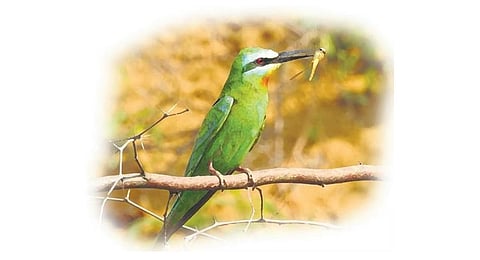

I was waiting in a small town for a vehicle, which would take me to a tiger reserve, my field site for the season. People milled around me, but time passed slowly; I wanted to be on the road, away from habitation. Eschewing my phone, I looked at the world around me. On a Gulmohar tree branching above my head, a pair of green bee-eaters—striking birds with long beaks—were hunting dragonflies.
They would take off from a branch, and inevitably return with an insect in their mouth. The sun shone strongly, but the birds never tired. Bee-eaters are named after their love for bees, which they hunt with great precision, but any winged insect is fair game. Watching their alert, tireless sorties was like stopping time—it seemed all motion was concentrated in the blur of their wings and the dart of their beaks.
In another part of the country, during the monsoon, I watched blue-cheeked bee-eaters near a sandbank. The shoulder of sand had holes in it, and the birds never went far from them. These cavities were, in fact, nests, many of which had chicks in them. The parent birds would fly, amid a mass of fast dragonflies or towards slower butterflies with a dipping sort of flight. They would soon return with an insect for their ravenous chicks.
During the rainy season, and shortly after, the air is full of dragonflies. They are strong fliers and even stronger pest-control agents—the young hatch under water, and eat mosquito larvae. So, a pond with dragonfly nymphs is a clean one. When dragonflies grow older and emerge from the water, they continue eating other insects.
Of course, they are no match for a bird with a strong beak and aerial combat skills. Watching a tough bird bring down a sturdy insect is like watching the web of life unfold. And at this time of the year—right after the rains—the food web makes itself a bit more obvious. The air shimmers with dragonflies, swarming in masses in the sky. When they are still, they look like jewels, often perched in a row on a branch or a clothesline. They love soaking up the sun—and in doing so, will give you a good look of their alien-like head, clear wings, and a strongly marked body.
In another month or so, Amur falcons, flocks of migrating birds of prey, will enter Indian territory. They come from China and Siberia at the end of October to north-eastern India, and snap up post-rain bounty: termites and dragonflies. Each bird eats hundreds of insects a day.
The business of life, of feeding and living, is all around us. Watching a bird streak through the sky, chasing an insect that has evolved to get away—fast like a missile—is like watching wild abandon. It is perhaps closest to what the phrase, ‘a free bird’ connotes.
If you like a bird or animal, don’t stop at admiring its beauty, colour, or plumage. Find out what it eats too. This will connect you with earthy things like the puddle where a dragonfly was born, the leaf a caterpillar lives on, or the log of wood a termite came from. The more you uncover these connections, the more complex a picture will emerge. And you will come away richer for it, perhaps even more energised.
Neha Sinha
Conservation biologist and author
Posts on X (previously Twitter) @Nehaa_sinha